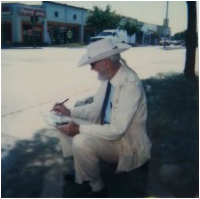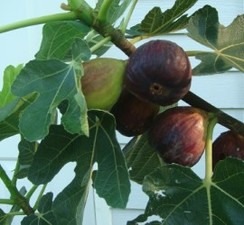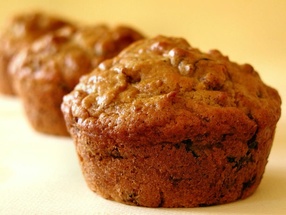The first fig tree that caught my imagination was in my grandparent’s back garden. It grew sprawled against a southern wall, with gnarled limbs growing every direction, branches lifting skyward before dipping down, parallel to the ground. It fit perfectly into Pat’s garden which was more of an art project than typical garden. This tree delighted both of them. Grandpa Pat drew and painted its complexities while Grandma Lady made the sparse fig harvest into fig muffins. In retirement, Pat sketched and painted daily whether in the back garden, front room, side of the road or anywhere he found himself. In photographs, you see various grandchildren and great-grandchildren leaning in, smiling at the camera, while Pat is looking up from a sketch book. Lady was not a natural cook or baker, and made these muffins to please Pat, with a sense of play acting about it.
Both my grandparents possessed PhDs, defying stereotypes throughout their long lives together. Aunt Rose sees the fig tree as a metaphor for their chaotically charming, artistic, eclectically intellectual and unorthodox lifestyle. I agree wholeheartedly. Their house was stuffed with books and art and the souvenirs of their travels. Lady would sometimes write her grocery lists in Greek or Latin and Pat never stopped studying history and languages. A vocabulary list in Japanese characters could often be found in his pajama breast pocket. These were the grandparents who took the grandchildren to plays and museums and out to Japanese, Mexican, Indian food.
No grandchildren ever had more interesting grandparents. On a wheeled tea cart resided Lady’s silver tea service, endlessly fascinating for at first pretend, and later real, afternoon teas. I felt very honored with the responsibility of keeping the set polished. My own impulse to collect silver I lay squarely at Lady’s door. Her tea service has now passed to me and resides in a place of honor in my living room. We are so lucky to have Pat’s paintings and Lady’s silver to keep them close by us, though they, and their beautiful fig tree, are gone.
The second fig tree in my life is my parents’ Flanders fig tree, a proper looking fig tree, according to Rose, perhaps representing their more settled, orderly and cozy lifestyle. As with most of my father’s plants, this little fig tree is the very model of robust perfection. His garden produces an abundance of edible vegetables to be cooked into meals, daily. During the year, I serve cheese using the big glossy leaves to line the platter and at harvest, we pick heavy, dusky purple figs every day. The neighborhood cats use the lush foliage as their secret hiding spot.
This years’ fig crop is enormous. We are eating them for breakfast and sharing baskets of figs with all visitors. We will freeze peeled, mashed fig puree for sammartini cookies at Christmas time. You’ll find the recipe at our website, www.myteaplanner.com. My Italian grandfather Joe brought the recipe over from his native Calabria (The name sammartini seems to be specific to the Pedulla family—we have not encountered it elsewhere. Sicilians use the term cuccidati or “cucci.”)
The ripest figs will go into fig jam; if you take the time to peel the figs, the jam will remain a beautiful pinky color instead of the usual brown hue one sees in commercially made jam. Not everyone had tried fresh figs, their having such a brief season. I recommend seeking them out at the farmer’s market or keeping an eye out in your neighborhood for a graceful fig tree tucked into someone’s yard. A fig tree makes a beautiful and giving friend.
Unfortunately, I can’t give our fig jam recipe because we never remember to write down the amounts of fig pulp or sugar we use. We usually begin by looking up the recipe for fig preserves in the Ball Blue Book of Preserving, which everyone should own. Next, we see how much peeled fig pulp we have then cut the recommended ratio of sugar down. Toward the end of cooking, we add fresh lemon juice. Jam making is very rewarding but is one of those things which is variable; some years the jams will be better than others but homemade jams will always be better than store bought!
Here is the fig muffin recipe, from Lady to all of you, for when you have extra fresh figs or you want to please someone special.
Fresh Fig Muffins
I suspect my non-baking grandmother Lady adapted this recipe from an apple sauce muffin recipe. It possibly came from her thick Settlement Cookbook, which was one of the few cookbooks in her house, and which has now unfortunately been lost. As she did, you can swap out a different fruit purée for the figs or applesauce such as cooked and mashed pumpkin or squash, or very ripe mashed persimmon pulp.
Fresh Fig Muffins
I suspect my non-baking grandmother Lady adapted this recipe from an apple sauce muffin recipe. It possibly came from her thick Settlement Cookbook, which was one of the few cookbooks in her house, and which has now unfortunately been lost. As she did, you can swap out a different fruit purée for the figs or applesauce such as cooked and mashed pumpkin or squash, or very ripe mashed persimmon pulp.
2 cups flour
12 cup sugar
2 teaspoons baking powder
12 teaspoon baking soda
12 teaspoon salt
12 teaspoon ground nutmeg or mace
1 cup peeled and mashed fresh fig
14 cup vegetable oil or melted butter
1 egg, slightly beaten
Cinnamon sugar for dusting, if desired
Preheat oven to 400˚ F
Special equipment: muffin pan, sprayed with baking spray or lined with muffin papers, large mixing bowl, 2 cup glass measuring cup, silicone spatula
12 cup sugar
2 teaspoons baking powder
12 teaspoon baking soda
12 teaspoon salt
12 teaspoon ground nutmeg or mace
1 cup peeled and mashed fresh fig
14 cup vegetable oil or melted butter
1 egg, slightly beaten
Cinnamon sugar for dusting, if desired
Preheat oven to 400˚ F
Special equipment: muffin pan, sprayed with baking spray or lined with muffin papers, large mixing bowl, 2 cup glass measuring cup, silicone spatula
Makes 12 muffins
- In large mixing bowl, stir together flour, sugar, baking powder, baking soda, and nutmeg. Set aside.
- In glass measuring cup, stir together mashed fig, oil, and egg. Add to flour mixture, stirring with spatula just until wet ingredients are incorporated.
- Divide batter between prepared muffin pan wells. Sprinkle tops with cinnamon sugar, if desired. Bake for 18 to 20 minutes or until toothpick inserted into center of muffin tests clean. Serve warm or at room temperature. Store loosely covered for up to three days or freeze, tightly wrapped, for up to one month.







